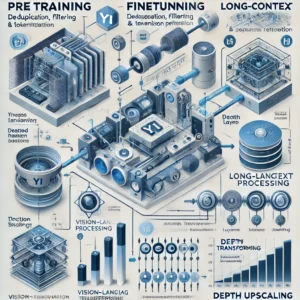In the realm of large language models (LLMs), the trend has often been to scale up: more parameters, more tokens, and more computational costs. But with Phi-4, Microsoft Research demonstrates a different philosophy. By emphasizing data quality, synthetic datasets, and innovative training methods, Phi-4 delivers cutting-edge reasoning capabilities while maintaining a modest parameter count of 14 billion.
This blog delves into the breakthroughs, design principles, and potential applications of Phi-4, highlighting its unique position in the competitive landscape of LLMs.
Why Phi-4 Stands Out
Phi-4 is a 14-billion-parameter language model developed to excel in reasoning-focused tasks. Despite its relatively small size compared to models like Llama-3 and GPT-4, it rivals or surpasses these giants in key benchmarks, particularly in STEM domains. This success stems from three core innovations:
- Synthetic Data-Centric Training: Leveraging synthetic datasets tailored for reasoning and problem-solving.
- Advanced Post-Training Techniques: Including refined Direct Preference Optimization (DPO) and pivotal token search.
- Minimal Architectural Changes: Retaining the simplicity of its predecessor, Phi-3, while delivering exponential performance improvements.
Synthetic Data: The Game Changer
Unlike traditional models that rely heavily on organic web data, Phi-4 uses synthetic data as the cornerstone of its training. This approach offers several advantages:
- Structured Learning: Synthetic data ensures step-by-step reasoning, mimicking how humans tackle problems systematically.
- Alignment with Inference Contexts: Tailored data helps the model perform better during inference by closely resembling real-world interaction formats.
- Diversity and Nuance: Synthetic datasets cover a broad spectrum of skills, including advanced problem-solving and edge-case scenarios.
The synthetic data pipeline employs techniques like:
- Multi-agent prompting: Collaborating prompts to create diverse datasets.
- Instruction reversal: Generating instructional prompts from outputs, especially in coding tasks.
- Self-revision workflows: Iterative improvements based on model feedback.
Performance Benchmarks
Phi-4 excels across reasoning, mathematics, and coding benchmarks, as demonstrated in Table 1 of the report. Highlights include:
- Graduate-Level STEM QA (GPQA): Achieving 56.1%, significantly outperforming GPT-4o-mini and Phi-3.
- Mathematics (MATH): Scoring 80.4%, a leap from its predecessor’s 44.6%.
- Coding (HumanEval): Scoring 82.6%, showcasing its prowess in real-world programming challenges.
The model also performs well in long-context scenarios, thanks to its midtraining phase, which extends its context length from 4K to 16K tokens.
Innovative Post-Training: Beyond Fine-Tuning
Phi-4’s post-training process is designed to enhance reasoning, robustness, and safety. Key techniques include:
- Supervised Fine-Tuning (SFT): Using high-quality, curated datasets across diverse domains.
- Direct Preference Optimization (DPO):
- Stage 1 (Pivotal Token Search): Identifying key tokens that impact success probability and refining them for reasoning-heavy tasks.
- Stage 2 (Judge-Guided DPO): Creating response pairs based on GPT-4 evaluations to improve accuracy and user alignment.
These methods ensure the model excels in reasoning tasks and reduces hallucinations in scenarios where the model is uncertain.
Applications of Phi-4
Phi-4’s capabilities make it a valuable tool across various domains:
- Education: Assisting students with STEM problem-solving and providing step-by-step explanations.
- Software Development: Automating debugging, code generation, and explanation tasks.
- Research: Tackling complex mathematical proofs and scientific queries.
Its smaller size and optimized training also make it a cost-effective solution for enterprises seeking AI capabilities without requiring extensive computational resources.
Safety and Ethical Considerations
Microsoft’s Responsible AI principles guided the development of Phi-4. The model underwent rigorous red-teaming and safety testing to mitigate risks such as:
- Data contamination.
- Instruction-following weaknesses.
- Factual hallucinations.
The team employed tools like adversarial suffix testing and safety-specific DPO datasets to enhance robustness.
The Road Ahead
Phi-4 showcases the power of innovation over brute-force scaling. By refining data quality and training methodologies, it achieves remarkable results in reasoning and problem-solving tasks. Looking forward, integrating post-training insights into the pretraining stage could further enhance its performance.
With Phi-4, Microsoft Research sets a precedent for creating efficient, capable, and ethical AI models. Explore the future of reasoning with Phi-4—proving that bigger isn’t always better.






Be First to Comment